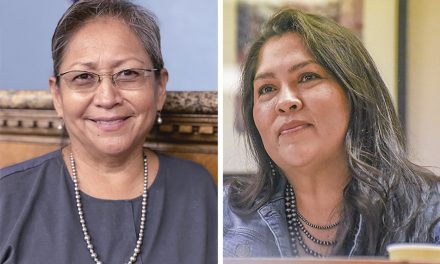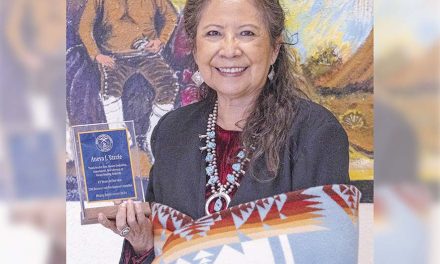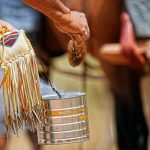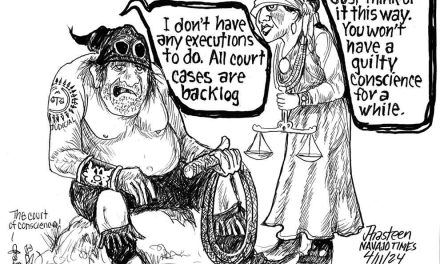
50 years ago: Nakai vows not to ask for raise
The Navajo tribe’s chairman, Raymond Nakai, a former chairman, Paul Jones, and a man who had wanted to be chairman for more than a decade, Sam Billison, were in the midst of a political battle to become the next chairman. The last thing any of them wanted was for people to start talking about how much the chairman makes.
Nakai made, according to the Navajo Times, $20,000 a year as chairman. This was viewed as a good salary in those days when the average annual income of a Navajo was less than $5,000 a year, although that figure is a little suspect since it did not take into account income made by Navajos who worked off the books, such as those who made arts and crafts.
But Nakai’s salary had come up here and there as members of the Old Guard who disliked Nakai questioned at times whether he was being overpaid, since he not only got a salary but a free home and the free use of a tribal vehicle.
But Nakai pointed out that his home was still located in Lukachuakai and he planned to go live there when his days as chairman were over, so he had to maintain a home and property there as well.
When asked about his salary at a campaign rally (a question possibly planted by one of his opponents), Nakai said he had no plans to ask for an increase if he is re-elected.
But in those days, increasing the salary of a tribal elected official didn’t only take a resolution approved by the Navajo Tribal Council. The measure would also need approval of the Bureau of Indian Affairs at the time since the BIA considered itself responsible for making sure the council used the money wisely.
But assuming Nakai wanted a raise and was willing to risk the election to get it, he would have a better chance of having the BIA approve it than the council because he still had a lot of opposition from the Old Guard.
So he made it clear at rallies and campaign speeches that he had never pushed and would never push to get a raise.
But just when Nakai probably thought the subject was dead, at least until after the election, something else cropped up that he had no control over.
There was major news from Washington that the U.S. Senate was looking at a bill that would increase the minimum wage in this country from $1.25 an hour up to $1.60.
This would have an effect on the Navajo tribal government since a lot of the lower-level people were making minimum wage or close to it. One estimate from the tribe’s financial office was that an increase to $1.60 an hour would force some layoffs.
It’s difficult to say which position Nakai took on increasing the minimum wage since he seemed to say something in Chinle that he would not repeat in a chapter like Low Mountain. If you were a reporter who understood Navajo and went to one of his chapter meetings and wrote down what you think he said, the chances were good that one of his aides would come by the Navajo Times office after the paper came out and say you misquoted him.
But for the most part, Nakai tried to shy away from talking about people’s salaries, including his own.
Still on he subject of money, a dispute arose over tribal funds that would continue throughout the rest of the year into 1967.
The Gallup Independent was given documents from someone in the BIA that showed where the Interior Department deposited the tens of millions of dollars that the Navajos had sitting around.
What the documents showed was $12 million of tribal funds were deposited in two banks in Buffalo, N.Y. while $9 million was being held in three Arizona banks.
Now the use of the Arizona banks was not a big deal but questions arose about why Buffalo was getting the money when both the tribe and federal law required it to be put in a bank near the reservation.
The theory behind this was simple.
If you deposit millions of dollars in a bank that tribal members had access to, maybe that bank would be willing to let tribal members get loans to repair their homes or go into business for themselves.
Just two weeks prior, when the tribe had had a special audit, it was revealed that the tribe had $52 million over and above its needed operating needs, so there was a lot of talk about how to use this money. The funds were sitting in banks and collecting 1 percent or 2 percent interest when tribal financial officials felt it could make as much as 4 percent if it was deposited somewhere else.
But, as the Navajo Times would later point out, it wasn’t the tribe’s decision where to put the money. That was up to Interior Secretary Stewart Udall himself.
To read the full article, pick up your copy of the Navajo Times at your nearest newsstand Thursday mornings!
Are you a digital subscriber? Read the most recent three weeks of stories by logging in to your online account.







 Highway 264,
Highway 264, I-40, WB @ Winslow
I-40, WB @ Winslow